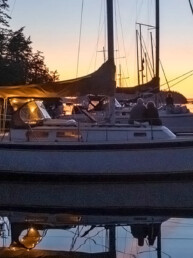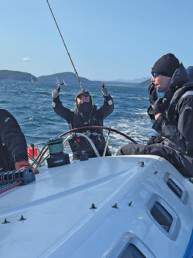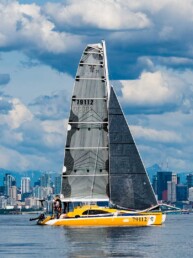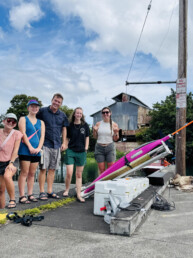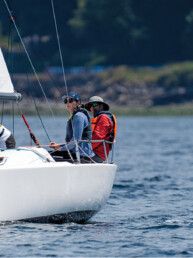From the November, 2020 issue of 48° North.
EXPLORING AN UNSUNG ANCHORAGE AND SEAPORT
This year created cruising challenges and opportunities around the Salish Sea, with the Covid-19 pandemic and the border closure between the U.S. and Canada. Reduced guest moorage capacity and increased activity left popular anchorages in the San Juan Islands bursting at the seams with boaters.
This was not a problem for the crew of Nordic Sun II, our Hylas 44. We treated it all as a catalyst to think “out of the boat” and it led my wife, Heather, and I to new ports that we hoped would not be frequented by the masses. The historic seaport of Coupeville fit our criteria, and was a very rewarding stop.
As we enter the winter cruising season with less daylight, many of us will be looking for less-trafficked local destinations that do not require crossing the Strait of Juan de Fuca in volatile weather. Again, Coupeville fits the bill, with protected access from the north and south.
OUR ARRIVAL
We approached Coupeville on one of those very smoky days in September. With limited visibility, we approached the wharf at almost dead slow speed. About a quarter-mile out, we could make out the big red building on the end of the historic wharf. It sported a prominent welcome sign, and I could imagine the old steamers pulling in with their skippers yelling, “Next stop Coupeville!”
After dropping the hook in front of the wharf near another anchored sailboat, we dinghied in to the guest dock and proceeded up the narrow gangway. We paid the harbormaster the $5 fee, which is required for docking a dinghy. A faint outline of Front Street, the main drag along the waterfront, could be barely seen from the end of the wharf through the fog-like-smoke. This wharf has seen a lot of supplies and people move across its planks over the years. However, today there were only a handful of tourists and a maintenance truck using the pier.
WHERE IS COUPEVILLE AND HOW CAN YOU GET THERE
Coupeville is located on the east side of Whidbey Island, on the southern shores of Penn Cove. You can get there by boat from either the north or south. We approached Coupeville from the north, along Skagit Bay via Deception Pass. There is another northerly route, which passes Anacortes heading for the Swinomish Slough—this route takes you past the charming seaport of La Conner. You can also get there from the south, by heading up Possession Sound and Saratoga Passage to Penn Cove on the east side of Whidbey Island. Even with all of this accessibility by boat, judging by the number of cars parked along the street, I believe most of the tourists came by car—using State Route 20 and crossing the historic Deception Pass Bridge.
MOORAGE, FUEL AND PUMP OUT FACILITIES
There is overnight moorage at the guest dock next to the wharf or you can anchor out in the bay, as we did. There is only 400 feet of dock space, which is available on a first-come first-served basis. When we were there, only two guest boats were at the dock, along with the historic schooner, Suva.
A LITTLE HISTORY
Coupeville has a long history, and it’s proud of it. Historical information is on display around the town and wharf, and the following was especially interesting to us.
By the time the first Europeans sailed into the cove, the Salish people had already lived in Penn Cove for centuries. The first documented arrival was when Joseph Whidbey, of Captain Vancouver’s crew, visited here in May of 1792, during the Voyage of Discovery. At that time, there were a number of villages in the cove, the largest of which was located where present day Coupeville is today.
Coupeville gets its name from the sea captain, Thomas Coupe, who settled in Penn Cove in 1852. He was later joined by his wife Maria and their children in 1853. The Coupes did not initially file for ownership of their property, instead it was C. H. Ivans who first filed a claim. The Coupe’s paid Ivans for the property and were eventually granted ownership.
In 1881 the town became the Island County seat and started to grow as more people settled in the area. In those days, the best way to get to Coupeville was by ship. Coupeville was a main stop for the early steamers running between Bellingham and Olympia. The steamers brought people to Coupeville and the islanders shipped out grain. The town was incorporated in April, 1910.
In 1935, the bridge over Deception Pass was completed. The bridge allowed Whidbey Island residents to visit the mainland by car, and vice versa. The new road brought tourism, which is now the mainstay of the Coupeville economy.
Coupeville is the home port for the pilothouse schooner, Suva. It was built for Thomas Pratt, a Coupeville local, in 1925. A prominent Seattle naval architect L.E. (Ted) Geary designed the schooner. It was built in Hong Kong out of old growth teak. It is now open for public tours and sailing charters.
THE WHARF
The wharf that sticks out into Penn Cove, with its big red building, is known as the Grain Wharf. It was built in 1905 to facilitate easier shipment of locally grown grains during the low cycles of the tide. Today the Grain Wharf houses a marine education center, with a collection of marine mammal skeletons hanging from the ceiling. Each of these skeletons was found on Island County beaches, with the biggest one being from a gray whale.
The building also houses the harbormaster’s office, a restaurant, and a gift shop that caters to boaters and tourists. The wharf is one of the most photographed structures in Coupeville. Winter storms and the “The King” high tides have taken their toll on the old wharf, so it is now in need of some repairs. The Coupeville Historic Waterfront has ongoing fundraisers if you’d like to help preserve the wharf for future generations.
WHAT TO SEE AND DO IN TOWN
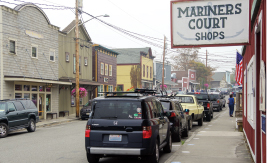
As I reached the end of the wharf, I finally got a good look at the waterfront portion of town. Most of the buildings are the original structures built here in the late 1800s and early 1900s.
The quaint old buildings of Coupeville—which used to house businesses such as the livery stable, butcher shop, barber shop, and saloon—now support niche boutiques, wine tasting rooms, restaurants, art galleries, and other specialty gift shops. Each surviving structure has a historical plaque stating its age and the name of the original business or owner. This gave a real sense of the types of businesses that helped this old seaport grow in those early years. The old Gillespie Meat Market, established in 1887, was the first building east of the wharf that I came across. It now houses a boutique.
I went to the old fire station, one block up from the wharf. Nowadays, it houses the visitor center. I used the information from the center to plot my course for what to see and where to go. Across the street from the visitor center, I noticed an old block house and some dugout canoes. They were outside the Island County Museum. Open seven days a week, it contains lots of artifacts and information from the area. It is a must see if you would like to learn more about the geology and history of the Coupeville area.
While Heather was visiting the unique boutiques and shops around town, I explored beyond the waterfront. I found lots of historic points of interest using the walking tour map I obtained at the visitor center. I didn’t have to stray too far to find the oldest home in town, the one owned by Captain Thomas and Maria Coupe, which was built in 1854. By the time I was done walking and Heather was done shopping, it was time for refreshments.
There were a number of different eateries in town. We went to Toby’s, which is famous for its mussels. The pub occupies the old Whidbey Mercantile Company building. The atmosphere of this hometown restaurant and tavern was warm and friendly and they served us huge portions of local seafood at an affordable price.
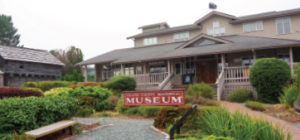
Our day exploring the town wouldn’t be complete without stopping by the ice cream store for a triple scoop waffle cone. Their building was originally built to hold the Island County Abstract Office in 1890. If you are a Seattle’s Best Coffee lover, it is notable that its founders, Jim and Dave Steward, opened their first coffee shop here in 1969 in the same shop that now serves up delicious ice cream.
Coupeville hosts a number of events every year that bring people to this historic town. One of those is the annual Penn Cove Water Festival, held in the springtime. The festival is family-oriented with crafts, great food, and Native American canoe racing. Canceled in 2020, it is expected to be back in the spring of 2021.
OTHER THINGS CLOSE BY
We came by boat and only had one day to explore this historic seaport, therefore only had time to see the sites within walking distance. If you come by car or catch some other mode of transportation, like the free county bus service, there are other beautiful and historic sites to explore, including:
- Fort Casey State Park (https://parks. state.wa.us/505/Fort-Casey)
- Ebey’s Landing National Historical Reserve (www.nps.gov/ebla/index.htm)
- Admiralty Head Lighthouse (www. lighthousefriends.com/light.asp?ID=31)
- Take a sail aboard the historic schooner SUVA (www.schoonersuva.org/)
- Deception Pass State Park (www.parks. state.wa.us/497/Deception-Pass)
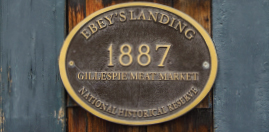 The old seaport of Coupeville still maintains much of its yesteryear look and personality. Grain and supplies may no longer be shipped from the wharf, but it is still well used by boaters and tourists. We really enjoyed our time in this historic seaport of the Salish Sea. We will be back to soak up more of this old town’s salty air charm, and to visit some of the other historical sites nearby. If you are considering taking a short trip from the Seattle area and beyond, whether by boat or automobile, you can’t go wrong checking out Coupeville.
The old seaport of Coupeville still maintains much of its yesteryear look and personality. Grain and supplies may no longer be shipped from the wharf, but it is still well used by boaters and tourists. We really enjoyed our time in this historic seaport of the Salish Sea. We will be back to soak up more of this old town’s salty air charm, and to visit some of the other historical sites nearby. If you are considering taking a short trip from the Seattle area and beyond, whether by boat or automobile, you can’t go wrong checking out Coupeville.
Historical information for this article provided by the Coupeville Historic Waterfront Association, the Coupeville Visitor’s Center, and Margaret Riddle’s essay on Coupeville for historylink.org.
Greg Larsen
Cruiser/Racer with a lifetime of sailing experience, Greg and his family have been cruising the waters of the Salish Sea from Olympia to Alaska for decades.


